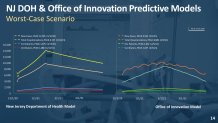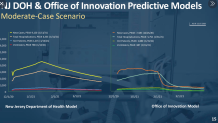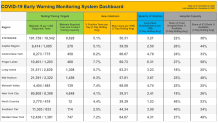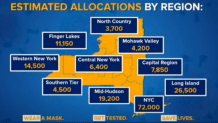What to Know
- Two New Jersey agencies devised worst-case and moderate COVID-19 projection models that account for real-time data, trends and make a series of assumptions about human behavior
- Gov. Phil Murphy says he's going to look carefully at hospitalizations in the next week or so; those tend to rise about a week or two after case spikes and could lend more insight into the Thanksgiving effect
- In New York, Gov. Andrew Cuomo has tied hospitalization rates to the fate of indoor dining; he also plans to release a revised post-Thanksgiving hospital plan on Friday based on new guidance
COVID-19 numbers in New Jersey have been at their steepest levels -- and higher, at times -- than they were in the spring, a trend reflective both of enhanced testing and a U.S. crisis that shows no signs of abating. How much worse could they get?
Hospitalization numbers could turn direr than they were in April and daily cases could double in the next month with no change in public behavior, under the Garden State's worst-case scenario.
If public compliance improves -- and people heed holiday warnings -- it doesn't have to get to that point, according to the moderate projection outcome model Gov. Phil Murphy outlined Wednesday.
Two New Jersey agencies -- the Department of Health and the Office of Innovation -- devised independent analyses for both worst-case and moderate scenarios as far as the state's next six weeks battling the coronavirus. Both are based on real-time data, trends and a series of assumptions on human behavior.
Under the worst-case scenario, which assumes no change in compliance with masks, social distancing and avoidance of mass gatherings, New Jersey would see weeks of increasing cases, peaking between 12,595 and 9,932 in mid-January to early February, based on the two agencies' models. The state would see more hospitalizations than its 8,300 April peak under either analysis -- and that metric would be most magnified between mid-January and early February.
Right now, statewide hospitalizations are at 3,533, about 40 percent of the level to which New Jersey predicts they could grow by early February, at the latest, under the worst-case scenario projections. Patients in ICUs and on ventilators would be fewer than in April, a projection that considers treatment improvement since then.

Under the moderate projection model, which presumes New Jersey residents "do a little more to continue with our masking, social distancing and avoiding gatherings," hospitalization metrics would remain within the state's safety zone.
They would peak around 6,333 in mid-January, by the Department of Health assessment, or 5,752 by the Office of Innovation' review. Both are lower peaks than April numbers and leave some room for a holiday-associated increase from the current number of people hospitalized the state as of Wednesday. New daily cases would continue to climb through at least Christmas if not longer.

It's not the daily case number in and of itself that New Jersey is most worried about, though. It's hospitalizations. That'll be the most critical metric in the weeks ahead, Murphy has said, as states brace for the anticipated increase from initial case spikes associated with Thanksgiving. The more hospitalizations, the more strain on the hospital system -- and the increased likelihood for additional virus deaths to weigh on the state's already stark -- and still growing -- toll.
"While the numbers of new cases are what provides the shock values for the headlines, and they should, it is the numbers in our hospitals which are of the greatest concern and the hardest numbers, if you will, when it comes to determining the steps we need to take as a state," Murphy said. "The metrics in our hospitals, and their ability to ensure treatment for those who need it, are the greatest indicators of our on-the-ground realities."
Unlike the April crisis peak, New Jersey is better equipped for this viral wave, having a stockpile of necessary PPE and lessons learned, said Judy Persichilli, the state's health commissioner. She urged people to do their part mitigation-wise to lessening the overall impact and hospital strain this time around.
While Persichilli's and the Office of Innovation's modeling have some variations in potential outcomes over the next few weeks, there's one constant, Murphy said: "Our vaccination rates will not yet be in a place where they will have any significant impact on our path."
That's been the same message in neighboring New York, where Gov. Andrew Cuomo is also looking to shore up hospital capacity and resources ahead of an anticipated holiday-related surge. That's the top immediate priority, he has said. Earlier this week, Cuomo announced that the fate of indoor dining -- and possibly more -- hinged on the hospitalization rates in each of New York's 10 regions.

Indoor dining could be suspended entirely in New York City as early as Monday if it's hospitalization rate continues to increase, which Cuomo has said he expects it to do. Mayor Bill de Blasio debuted revised health indicators for his daily briefings on Monday, including the rolling hospitalization rate per 100,000 residents. It has increased in every report since and is well above the 2.00 he wants to stay below.
New hospital admissions have slowly ticked up over the last month but hit their highest daily number (196) Wednesday since May 10, de Blasio said. The city currently has a lower hospitalization rate than half of the state's regions, as of Cuomo's last report, but there's no singular threshold in this case. It's a matter of whether a given region can thwart ongoing increases.
For the rest of the state, excluding orange zones where indoor dining is suspended, indoor dining capacity will be cut to 50 percent or 25 percent if hospitalization rates don't stabilize within a matter of days. He didn't immediately provide an update on regional numbers at his briefing Wednesday but is expected to reveal a revised, comprehensive post-Thanksgiving hospital plan within days.
In New Jersey, Murphy has consistently declined to implement new indoor dining limits, citing no significant evidence that dine-in has contributed to the state's ongoing case surge. Asked to support his approach Wednesday, Cuomo said indoor dining is not as significant a spreader as it was at the height of the pandemic -- but he said that's because he has strict capacity limitations in place.
"They are still a source of spread," Cuomo said. "It's places of gatherings."
Some may disagree with his plan, but targeting indoor dining is merely one latest action in Cuomo's effort to avoid more draconian containment measures.
Daily Percentage of Positive Tests by New York Region
Gov. Andrew Cuomo breaks the state into 10 regions for testing purposes and tracks positivity rates to identify potential hotspots. Here's the latest tracking data by region and for the five boroughs. For the latest county-level results statewide, click here
Source: ny.gov
For the governor, the bottom line is whether hospitals can handle the increased patient volume until COVID rates start to see vaccination-related reductions. If they can't, and hospitals in a given region appear on track to hit 90 percent of capacity within three weeks, based on a seven-day average, it's shutdown time.
That means all schools, nonessential businesses and restaurant table service in the region in question - a level of lockdown most of the state hasn't seen since spring. No region is close to that yet, though Long Island and New York City are the nearest, with state data showing just 18 percent and 19 percent, of hospital beds open in those respective regions. Cuomo wants at least 30 percent free.

He ordered hospitals earlier this week to boost capacity by 25 percent and called on retired nurses and doctors to reenlist. They'll be reregistered at no cost in New York state as Cuomo looks to shore up resources for the expected winter spike.
More than 4,990 COVID-19 patients are now hospitalized statewide, more than double the number Nov. 18 and the highest total since May 20. With 19,000 or so admitted at the peak of the crisis in spring, Cuomo said the state isn't yet at a “critical” level of COVID-19 hospitalizations. But the growth rate is worrisome.
Daily deaths are on the increase in both New York and New Jersey -- New York reported its highest daily toll in months Wednesday (95) as New Jersey saw 91. Those statistics are nowhere near the jarring numbers from April, when the Empire State was losing about 800 people a day. But increases in critical hospitalizations will lead to some level of increase in deaths by default, despite enhancement in treatments for the most at-risk populations.
A vaccine is also on the near horizon -- and high-priority groups may get it within the next few weeks if the U.S. approves Pfizer's emergency use request as expected on Thursday.
New York and New Jersey both expect to receive initial doses of Pfizer's shipment within one week; they expect tens of thousands from Moderna, which takes up its request with the FDA a week after Pfizer, before the end of the month as well.
Cuomo said he expects New York to receive its initial allocation of 170,000 Pfizer doses as early as this weekend, presuming the FDA approves it, and further allocations in the coming weeks. High-risk healthcare workers and hospital staff receive first priority, followed by long-term care staff and residents. First responders get it next, then essential workers and finally, the general public.
By region, New York City is poised to receive the most initial doses from the state.

While a critical first step toward what will be a long road of recovery -- for states, cities and the nation as a whole -- widescale vaccination likely won't happen until at least midway through 2021. That won't stem the tide of an anticipated Christmas and New Year's surge on top of an expected Thanksgiving surge.
Dr. Anthony Fauci said earlier this week he expects the surge-upon-surge peak to fully materialize by mid-January. Without substantial and continued mitigation efforts, the nation's leading infectious disease expert warned that first month of 2021 could feature some of the nation's darkest days since the pandemic's onset.
For the nation, the days are already dark -- and darkening more by the day. U.S. deaths have soared to more than 2,200 a day on average, matching the frightening peak reached in April, and cases per day have eclipsed 200,000 on average for the first time on record, with the crisis all but certain to get worse.
Tracking Coronavirus in Tri-State
Worst-case scenario projections from the Institute for Health Metrics and Evaluation predict COVID-19 cases could peak Jan. 20 if states don't reimpose restrictions -- and that the daily tallies could be upwards of 1 million by that time. That model does presume a vaccine rollout beginning in a week or so.
At least 75 percent of the public must be vaccinated in order for the economy to return to some semblance of normalcy, experts say. According to Fauci, restaurants could likely open at full capacity and sports arenas and theaters could operate safely at that time. He says that could happen in the "back half" of 2021.
Right now, the race is on to educate a highly skeptical public about the various vaccines. Polls show high skepticism even among some first responders -- and disparate skepticism along racial/ethnic and socioeconomic lines.



